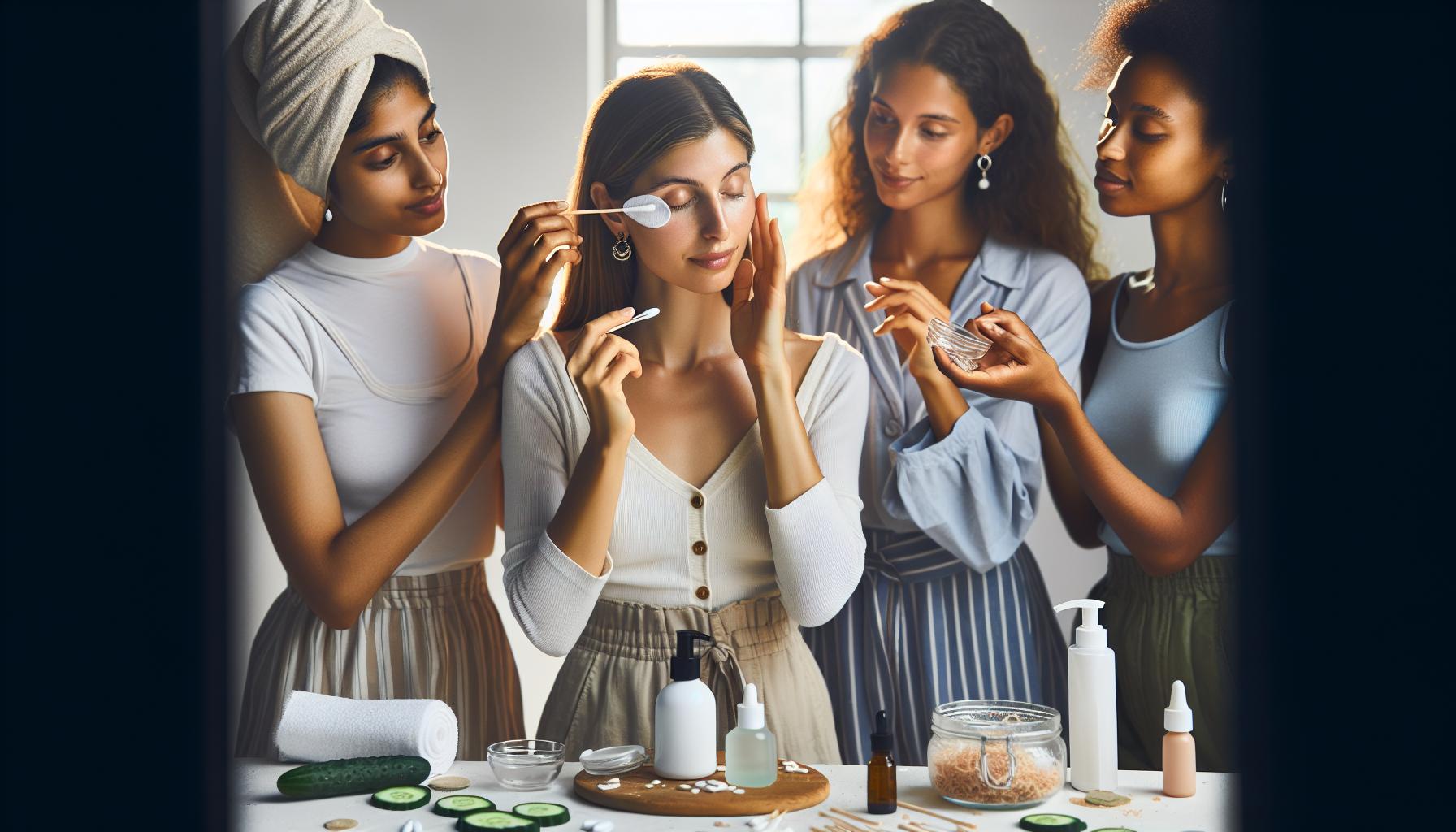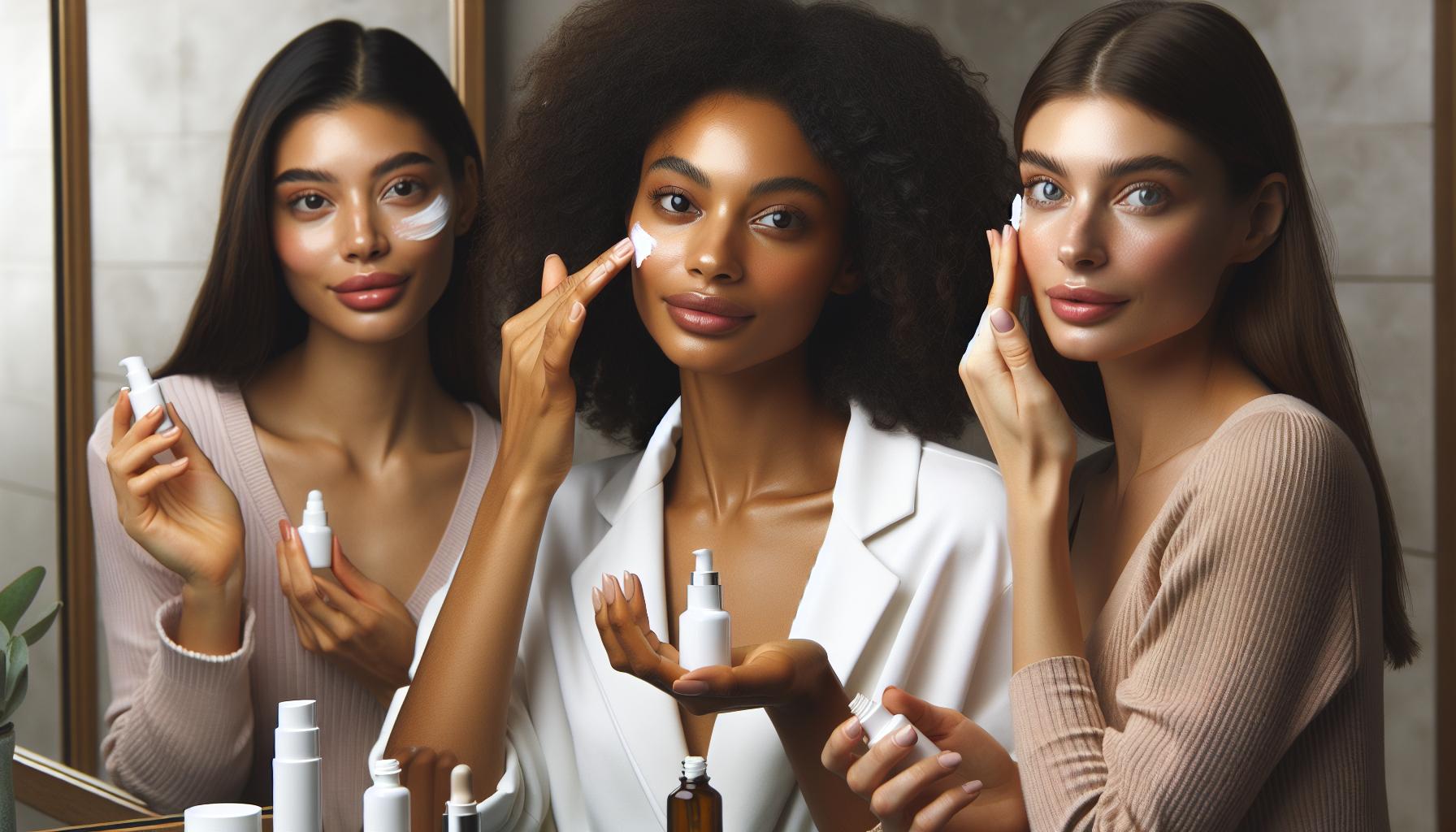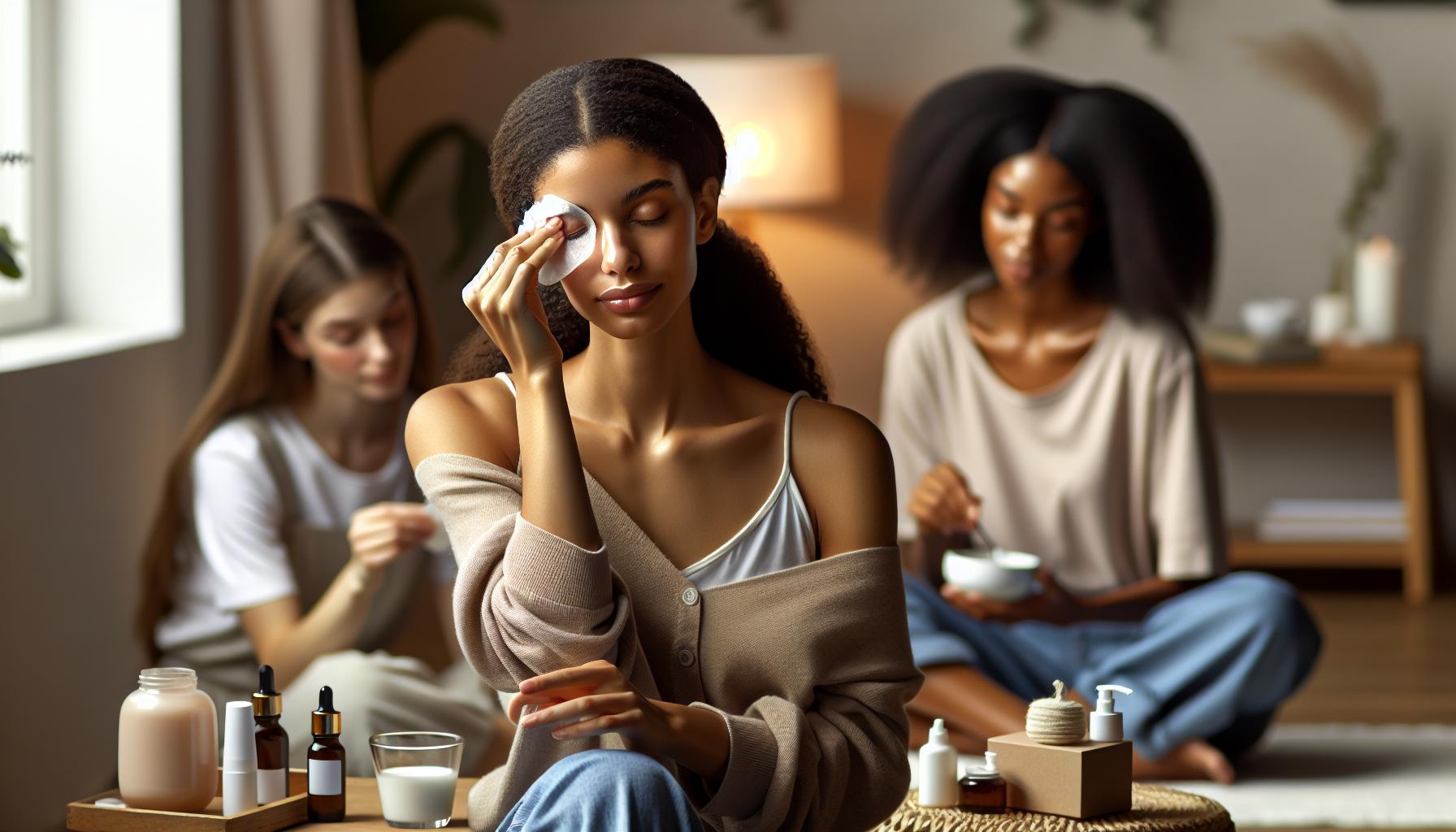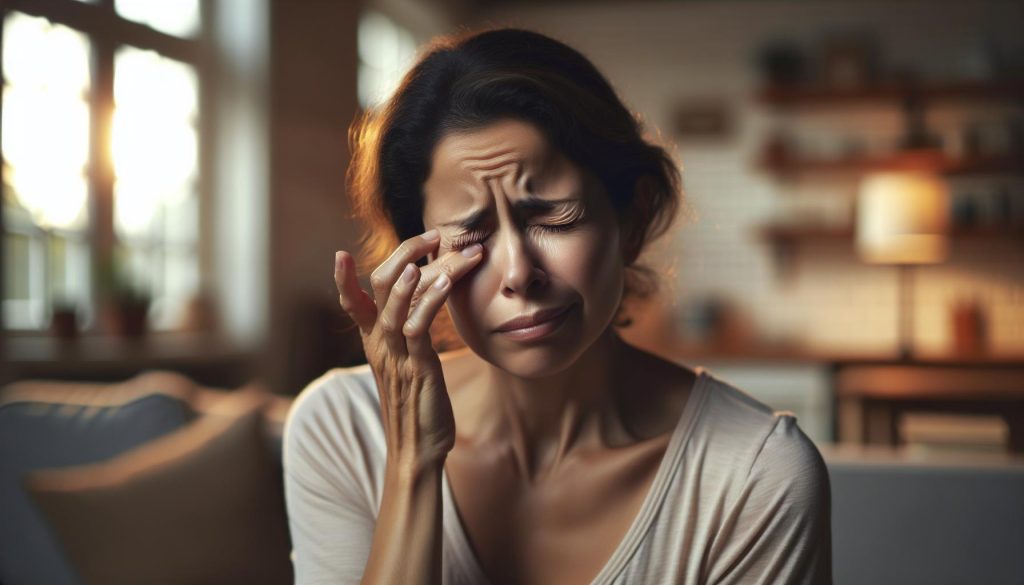Styes are not only common but can be quite bothersome, often causing discomfort and unsightliness. Understanding how to treat a stye effectively is essential for maintaining both eye health and your confidence. Whether you’re feeling a painful bump on your eyelid or are simply curious about prevention, this guide offers expert-approved methods to manage and alleviate styes safely and effectively.
By exploring these approaches, you’ll discover both immediate at-home remedies and when to reach out for professional care, ensuring you can return to your daily activities without the burden of discomfort. Keep reading to empower yourself with knowledge and reclaim your peace of mind through these practical and reliable stye treatments.
How Styes Form: Understanding the Causes
A stye is more than just a pesky bump on your eyelid; it reflects an imbalance in the delicate ecosystem of your eye area. Understanding how styes form can empower you to take proactive measures to prevent their occurrence. Typically, a stye arises from a bacterial infection, particularly affecting the oil-producing glands in your eyelids, known as meibomian or Zeis glands. When these glands become blocked or infected, they can swell and become tender, leading to the characteristic redness and discomfort of a stye.
The most common culprits behind these infections are bacteria, particularly Staphylococcus aureus, which can thrive on the skin’s surface. Factors such as poor hygiene, using old or contaminated cosmetics, or even touching or rubbing your eyes with unwashed hands can increase your risk of developing a stye. Stress, hormonal changes, and other conditions such as blepharitis or rosacea can also contribute to the likelihood of stye formation.
To further clarify, recognizing the science behind styes encourages a proactive approach. For instance, maintaining good eyelid hygiene-such as washing your eyelids regularly with a gentle cleanser-can help keep your glands functioning properly. Additionally, being mindful of cosmetic products and their expiration dates is crucial, as using old makeup can introduce harmful bacteria to the sensitive area around your eyes. By understanding these underlying causes, you can implement practical strategies to minimize the risk of developing styes in the future.
Recognizing Symptoms of a Stye on the Eye
The presence of a stye on your eyelid can be both uncomfortable and alarming, but recognizing its symptoms early can lead you to prompt relief and treatment. Typically, the hallmark of a stye is a painful red bump that appears on the edge of the eyelid, often resembling a pimple. This irritation occurs due to an infection of the oil glands, commonly caused by the bacteria Staphylococcus aureus. Understanding these symptoms not only aids in identification but also empowers you to take appropriate action quickly.
Other symptoms accompanying a stye may include:
- Swelling: The affected eyelid may appear swollen or puffy, creating an uncomfortable sensation when blinking.
- Tenderness: You may experience discomfort or tenderness around the bump, which can vary in severity.
- Increased tearing or dryness: The eye might feel excessively watery or dry, indicating irritation.
- Crusting: There can be crusting around the eyelid, especially after sleeping, which may also trap more bacteria.
- Light sensitivity: Bright lights may become uncomfortable as the stye affects your eyelid’s functionality.
Sometimes, a stye can develop into a more intense infection, leading to symptoms like fever or an increase in overall facial swelling. If you notice any of these signs, it’s essential to monitor your condition closely and consider seeking medical advice. Taking note of these symptoms will not only guide you in identifying a stye but also help in deciding when to resort to expert-approved treatment options, allowing for a more informed and proactive approach to your eye health.
Expert-Approved At-Home Remedies for Styes
Applying warm compresses is one of the most effective at-home remedies for alleviating the discomfort of a stye. The heat helps to unclog the oil glands in the eyelid, promoting drainage and healing. To do this, soak a clean washcloth in warm water, wring it out to avoid dripping, and apply it gently to the affected eyelid for about 10 to 15 minutes, several times a day. This simple and relaxing treatment provides not only relief from pain but also encourages the stye to come to a head, which can lead to it resolving faster.
Another beneficial approach is practicing good eyelid hygiene. Keeping the area clean is crucial in preventing further irritation and infection. Use a mild, non-irritating eyelid scrub or diluted baby shampoo on a clean cotton pad to gently cleanse the eyelid where the stye is located. This routine can help eliminate debris and bacteria that may contribute to stye formation. It’s essential to avoid touching or rubbing the affected area, as this can worsen the condition or cause new styes to emerge.
Additionally, incorporating dietary factors that promote eye health can contribute to an overall reduction in stye occurrences. Consuming foods rich in omega-3 fatty acids, such as fatty fish, walnuts, and flaxseeds, can help maintain optimal skin health, including that around the eyes. Hydration plays a vital role here too; ensuring you drink plenty of water throughout the day can help keep your skin, including the delicate skin of the eyelids, well-hydrated and functioning properly.
While these home remedies can provide significant relief, it’s pivotal to listen to your body. If a stye does not improve within a few days or shows signs of worsening, such as increased pain, pus, or swelling, it’s advisable to consult a healthcare professional. They can provide additional treatment options, including potential antibiotic ointments or other medical interventions that may be necessary for more serious cases. By combining these at-home strategies with attentiveness to your symptoms, you can effectively manage and treat styes while prioritizing your overall eye health.
When to Consult a Doctor for Styes
When a stye develops, it can often be treated effectively at home with gentle care and monitoring. However, there are critical signs that suggest it’s time to consult a healthcare professional. If a stye does not start to improve within a few days of home treatment, or if it seems to worsen instead-manifesting as increased pain, swelling, or the presence of pus-seeking medical advice is advisable. These symptoms might indicate a secondary infection or a more serious underlying issue that requires professional intervention.
For women, it’s particularly important to pay attention if the stye affects vision or if the eye becomes increasingly sensitive to light. These could be signs of complications that might escalate if left unaddressed. Consulting a doctor can provide clarity on the best course of action, which may include antibiotic ointments or, in some cases, drainage procedures to alleviate discomfort and promote healing.
Moreover, individuals with underlying conditions, such as diabetes or those with compromised immune systems, should be vigilant. A stye in these cases may have a higher risk of complications, and proactive treatment is essential. Engaging with a healthcare provider early can help ensure that a stye doesn’t impact overall health, allowing for a smoother recovery and better management of eye health.
In summary, while home treatments like warm compresses and maintaining good eyelid hygiene can often resolve milder cases, always prioritize your health. If in doubt, err on the side of caution. Seeking medical advice not only helps in treating styes effectively but also empowers you with the knowledge to care for your eyes better in the future.
Medications and Treatments for Styes
A stye, though often a minor inconvenience, can cause significant discomfort and concern. Understanding the treatment options available is key to managing this common eyelid condition effectively. In most cases, styes are self-limiting and respond well to simple, non-invasive treatments. A cornerstone of initial management is the application of warm compresses; these not only soothe the area but can also promote drainage by softening the clogged oils in the affected gland.
For styes that fail to improve with home care alone, consulting a healthcare provider is wise. Medications such as topical antibiotics may be prescribed to combat infection, especially if there are signs of an exacerbated condition, such as increased redness, swelling, or pus. In some instances, oral antibiotics might be indicated to address more widespread infections. If the stye becomes particularly large or painful, medical intervention could involve a minor procedure where the stye is lanced to relieve pressure and facilitate healing.
It’s also beneficial to consider over-the-counter eyelid scrubs, which can help maintain eyelid hygiene and prevent future occurrences. These products are often gentle and designed specifically for the delicate skin around the eyes. For those struggling with recurrent styes, understanding the potential triggers-such as stress, poor hygiene, or underlying skin conditions-is key. In these cases, an eye-care routine that includes regular cleaning of the eyelids and avoiding touching the face can bolster defenses against stye formation.
Ultimately, recognizing the signs of a stye and knowing when to seek out professional advice can significantly enhance your eye health. With the right treatment plan in place, you can ensure a swift recovery while maintaining comfort and minimizing disruption to your daily life.
Preventive Measures to Avoid Styes
Preventing styes is not just about treating them when they occur, but empowering your daily routine with simple yet effective eye care practices. An eye-catching fact to keep in mind is that styes often emerge from blocked oil glands, a situation that can be easily influenced by personal hygiene and lifestyle choices. By adopting a few preventive measures, you can significantly reduce the chances of developing this common eyelid condition.
Start by ensuring that your eyelids are kept clean. Regularly washing your face and eyelids with a gentle cleanser can help remove debris and reduce oil buildup. This is particularly important for those who wear makeup; always make sure to remove eye makeup thoroughly before bed to prevent clogged glands. Additionally, consider incorporating eyelid scrubs into your routine. These specialized products are designed to maintain eyelid hygiene and can be especially beneficial for individuals with a history of styes or blepharitis.
Another key preventive step is to limit the touching and rubbing of your eyes. Our hands come into contact with numerous bacteria and irritants throughout the day, and transferring these to your eyes can easily result in infection. Ensure your hands are clean, especially before applying makeup or touching your face. It’s also worth noting that stress can exacerbate skin conditions, including styes, so finding ways to manage stress, such as through exercise, meditation, or hobbies, can play a vital role in your overall eye health.
Lastly, pay attention to your lifestyle choices. A balanced diet rich in vitamins, especially vitamin A, omega-3 fatty acids, and hydration, supports skin health. Foods like carrots, fish, nuts, and leafy greens are beneficial for maintaining healthy eyes. Avoiding heavy makeup or products that can irritate the eyelids is essential, as well as replacing old makeup to minimize the risk of bacterial growth. By integrating these simple yet effective practices into your daily life, you’ll enhance your ability to prevent styes and promote overall eye wellness.
Dietary Factors That Affect Eye Health
A well-balanced diet plays a pivotal role in maintaining optimal eye health and can be instrumental in preventing conditions like styes. Your eyes, much like any other part of your body, thrive on vital nutrients that not only support overall wellness but also enhance the resilience of your skin and glands around the eyes. Several key dietary components can fortify your body’s defenses, reduce inflammation, and facilitate healing, making them essential for your eye care regimen.
Key Nutrients for Eye Health
Focus on incorporating the following nutrients into your daily meals:
- Vitamin A: Essential for proper vision and skin health, vitamin A can help stave off infections. Foods rich in vitamin A include carrots, sweet potatoes, and spinach.
- Omega-3 Fatty Acids: Known for their anti-inflammatory properties, omega-3s support the health of oil glands in the eyelids, which can minimize the risk of styes. Sources include fatty fish like salmon, walnuts, and flaxseeds.
- Antioxidants: Vitamins C and E, found in citrus fruits, nuts, and seeds, can help protect eye tissues from oxidative damage and may aid in recovery from infections.
- Zinc: Important for maintaining the health of the retina and may contribute to better overall skin health. It can be found in foods such as legumes, nuts, and whole grains.
Hydration Matters
Don’t underestimate the power of hydration for maintaining eye health. Drinking adequate water throughout the day helps keep your body’s systems running smoothly, including the production of tears, which are crucial for eye comfort and health. Aim for at least eight 8-ounce glasses of water daily, and consider increasing your intake if you find yourself very active or in a dry environment.
The Role of a Balanced Diet
Adopting a diet rich in whole foods can significantly impact not only your eye health but your overall wellness. Consider meal planning that emphasizes colorful fruits, leafy greens, healthy fats, and lean proteins. Avoid excessive consumption of processed foods laden with sugars and unhealthy fats, which can lead to inflammation and exacerbate skin conditions around the eyes.
By making these dietary choices, you’ll enhance your body’s ability to prevent styes while promoting a radiant, healthy appearance around your eyes. Prioritizing these nutrition tips supports not just your eyes but your entire well-being, ultimately contributing to a more vibrant, healthier you.
Common Misconceptions About Styes
While many people are familiar with the uncomfortable nature of styes, several misconceptions can cloud understanding and treatment of this common eye condition. One prevalent myth is that styes are caused by poor hygiene. Although bacteria can contribute to their development, other factors like oil gland blockage and eyelid inflammation play significant roles. Remember, even with good hygiene, styes can still occur from natural bodily processes or stress.
Another common belief is that styes can easily spread from one eye to another or to other people. In reality, styes arise from bacteria already present on your skin, so they aren’t contagious. This misconception can create unnecessary anxiety and lead to stigmatization, when in fact styes are merely localized infections.
Many individuals also wonder if touching a stye will cause it to grow or lead to worsening symptoms. The truth is, while excessive touching can aggravate irritation or even lead to additional infections, styes typically will not expand simply due to contact. However, it’s wise to avoid squeezing or trying to pop a stye, as this can spread bacteria and potentially lead to complications.
Lastly, a pervasive myth is that using makeup can completely mask a stye. While it might be tempting to cover up a stye with cosmetics, doing so can irritate the area further and may trap bacteria, exacerbating the issue or prolonging recovery. Instead, it’s advisable to minimize makeup use around the eye and allow the stye to heal naturally. Prioritizing rest and proper care will ultimately help speed up the healing process.
Understanding these misconceptions empowers you to make informed decisions about managing and treating styes effectively. Embrace accurate information, and you’ll be better equipped to deal with this common condition while fostering good eye health.
Caring for Your Eyes After a Stye
Caring for your eyes after experiencing a stye is crucial to promote healing and prevent future occurrences. Though styes are generally harmless and often resolve on their own, the proper aftercare can significantly enhance recovery and maintain overall eye health. One vital practice is to keep the affected area clean. Gently wash your hands before touching your face or eyes, and use a clean, warm, damp washcloth to apply heat to the stye for approximately 10 minutes, several times a day. This helps to reduce swelling and promote drainage from the infection.
In addition to maintaining cleanliness, be mindful of your beauty routine while your stye heals. It’s best to avoid eye makeup during this period to minimize irritation and prevent trapping bacteria around the eye. If makeup was worn before developing the stye, consider discarding old products to prevent re-infection. Opt for gentle, hypoallergenic skincare products to avoid further irritation. Remember, letting your skin breathe and heal naturally is essential.
Nutrition can also play a role in your healing process. Incorporate foods rich in vitamins A, C, and E, as well as omega-3 fatty acids, to support your body’s immune response. These foods aid in skin repair and overall eye health. Hydration is equally important, so ensure you are drinking enough water throughout the day.
Lastly, it’s essential to stay vigilant about any changes in your eye health following the healing of a stye. If you notice that new styes are forming frequently or if the area seems to become increasingly painful, seek advice from a healthcare professional. They can help identify underlying issues, such as blocked glands or systemic conditions, that may need to be addressed. Taking these thoughtful steps will empower you to care for your eyes effectively and gracefully, promoting long-lasting health and confidence.
Understanding the Difference: Stye vs. Chalazion
A common source of confusion arises when distinguishing between a stye and a chalazion, both of which can appear as bumps on the eyelid but have different underlying causes and characteristics. Understanding these differences is critical for effective treatment and prevention, ensuring that you can respond appropriately to instances that may arise in your eye health journey.
A stye, medically referred to as a hordeolum, typically results from a bacterial infection, specifically in the sebaceous glands or hair follicles at the edge of the eyelid. This infection leads to a red, painful lump, often accompanied by swelling, tenderness, and discomfort. Symptoms often develop rapidly, making it easy to recognize when one is forming. They tend to point towards the surface of the eyelid and may ooze pus. Effective at-home remedies for a stye include applying warm compresses to the affected area several times daily to help alleviate pain and promote drainage, as well as maintaining proper hygiene to prevent further irritation or infection.
In contrast, a chalazion is caused by the blockage of the meibomian gland, leading to a non-infectious lump that is typically painless and slower to develop. This blockage results in a hard, often larger bump that may look red but is not typically accompanied by the significant swelling seen in a stye. Chalazia can persist for weeks or months and may require different therapeutic approaches. If a chalazion doesn’t improve with conservative measures like warm compresses, more invasive treatment options like corticosteroid injections or surgical drainage might be necessary.
Key Differences between Styes and Chalazia
| Feature | Stye | Chalazion |
|—————-|——————————–|———————————-|
| Cause | Bacterial infection | Blocked oil gland |
| Pain | Painful and tender | Usually painless |
| Appearance | Red, inflamed, often swollen | Red bump, less inflamed |
| Development| Rapid onset | Develops slowly over time |
| Treatment | Warm compress, hygiene, sometimes antibiotics | Warm compress, possible injections or surgery |
Understanding these differences can help you make informed decisions when it comes to treatment options. Should you be uncertain about the nature of the bump or if it persists despite home care, consulting with an eye care specialist is advisable. They can provide tailored advice and appropriate interventions based on your individual needs, ensuring you maintain optimal eye health moving forward.
Long-term Eye Care Strategies for Women
Taking good care of your eyes is essential, especially as women face unique health challenges that can affect their eye health. A staple part of long-term eye care is the incorporation of simple yet effective strategies into your daily routine. Keeping your eyes healthy not only prevents common issues like styes but also enhances your overall well-being.
One of the foundational practices for maintaining eye health includes proper hygiene. Regularly washing your eyelids and lashes can help prevent the buildup of debris and oil, which can lead to clogged glands. Consider using a gentle eyelid scrub or warm water and mild soap. When it comes to makeup, avoid sharing products with others, and make it a point to replace mascara and eyeliner every three months to minimize the risk of bacterial infections.
Nutrition plays a significant role in eye health. Incorporate foods rich in antioxidants, omega-3 fatty acids, and vitamins A, C, and E into your diet. Leafy greens, carrots, citrus fruits, and nuts are excellent choices. Staying hydrated is also vital; drinking plenty of water throughout the day helps keep your eyes lubricated and can prevent dryness that may exacerbate irritation or lead to stye formation.
Additionally, regularly scheduled eye exams are crucial for early detection and treatment of potential issues. Women, especially those over 40, should get comprehensive eye exams at least every two years. This allows for monitoring of vision changes and screening for diseases such as glaucoma and cataracts. If you notice any unusual symptoms, like persistent redness or discomfort that could signal a stye or infection, seeking ophthalmic advice promptly will further ensure your ocular health.
Incorporating these strategies can empower you to maintain your eye health proactively. Prioritizing hygiene, nutrition, and eye exams, while remaining attuned to your body’s signals, fosters a holistic approach to caring for your eyes over the long term.
Tips for Maintaining Overall Eye Hygiene
Maintaining eye hygiene is crucial, particularly for women who may face specific health challenges related to eye care. One of the simplest yet often overlooked aspects is the regular cleansing of the eyelids and lashes. This practice helps eliminate oil, dirt, and bacteria that could contribute to conditions like styes. A daily routine with a gentle eyelid scrub or using warm, soapy water can significantly reduce the risk of clogged glands that lead to styes. Remember to clean your eyelids, especially if you wear mascara or eyeliner, as these products can harbor bacteria and contribute to irritation.
To further enhance eye hygiene, consider adopting these habits:
- Always Remove Makeup: Make it a point to thoroughly remove all makeup before bedtime. Leaving makeup on overnight can increase the risk of infection and irritation.
- Avoid Sharing Eye Products: Sharing mascara, eyeliners, or eyeshadow can spread bacteria easily. Instead, encourage the habit of personalizing your makeup kit.
- Limit Eye Touching: Touching the eyes with unwashed hands can introduce bacteria. Make it a practice to wash your hands frequently, especially before applying or removing eye products.
- Regularly Replace Makeup: Keep track of your makeup expiration dates and replace products, especially those used on the eyes, every three months. This reduces the risk of using contaminated products.
Additionally, monitor your eye care environment. Are you frequently exposed to dust or allergens? Consider using protective eyewear when doing activities that may lead to irritation or debris in your eyes. If you’re in a high-pollen area or around smoke, ensuring a clean environment can be a significant factor in maintaining eye health.
Finally, incorporating a balanced diet rich in omega-3 fatty acids, vitamins A, C, and E, and staying hydrated can contribute to overall eye wellness. Nutrition plays a key role in the health of your eyes, influencing not just their appearance but also their long-term functionality. Prioritizing these practices will empower you to maintain optimal eye hygiene, helping to ward off issues like styes and promoting better eye health overall.
Frequently asked questions
Q: What is the quickest way to relieve discomfort from a stye?
A: The quickest way to relieve discomfort from a stye is to apply a warm compress to the affected eye for 10-15 minutes, several times a day. This helps reduce swelling and promotes drainage of the blocked gland.
Q: Are there over-the-counter medications for treating styes?
A: While there are no specific over-the-counter medications for styes, using mild pain relievers like acetaminophen or ibuprofen can help manage discomfort. Always consult your healthcare provider for appropriate treatments.
Q: Can I use makeup when I have a stye?
A: It’s best to avoid using makeup, especially eye makeup, when you have a stye. Makeup can irritate the area, potentially worsening the infection and prolonging recovery.
Q: How long does it generally take for a stye to heal?
A: A stye generally heals within 7 to 10 days. Proper care, such as warm compresses and hygiene, can help speed up the healing process. If it persists longer, consult a healthcare provider.
Q: What should I avoid while treating a stye?
A: Avoid squeezing or popping a stye, as this can spread the infection. Also, refrain from touching your eyes with unwashed hands and steer clear of makeup and contact lenses until the stye resolves.
Q: Are there specific foods that can help with stye recovery?
A: Foods rich in vitamins A and C, such as carrots and citrus fruits, may help support your immune system during stye recovery. Staying hydrated and consuming anti-inflammatory foods can also be beneficial.
Q: What home remedies are effective for styes?
A: Effective home remedies for styes include warm compresses, eyelid scrubs, and maintaining good hygiene. Additionally, using chamomile tea bags as a compress can soothe irritation and promote healing.
Q: When should I seek medical treatment for a stye?
A: Seek medical treatment for a stye if it does not improve after 48 hours of at-home care, if it becomes extremely painful, or if you experience vision changes. An eye care provider can prescribe medications or perform drainage if necessary.
In Retrospect
Thank you for exploring our expert-approved methods for treating a stye on the eye. Remember, early intervention is key to alleviating discomfort and promoting healing, so don’t wait if you notice symptoms. For more insights, check out our articles on “Effective Eye Care Practices” and “Home Remedies for Common Eye Disorders,” as these resources will enhance your understanding and provide additional tools for maintaining eye health.
If you found this information helpful, consider subscribing to our newsletter for more women’s health tips and treatments. Your feedback is invaluable, so please leave your questions or experiences in the comments below-we love hearing from you! Together, let’s keep your eyes healthy and vibrant.




